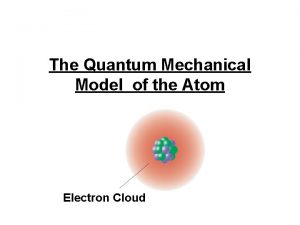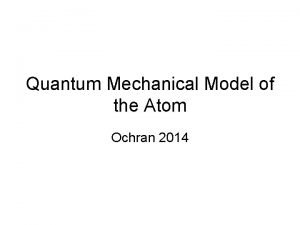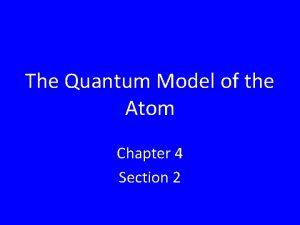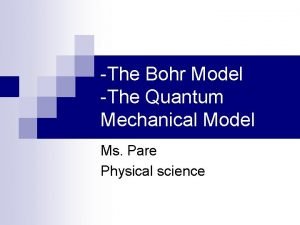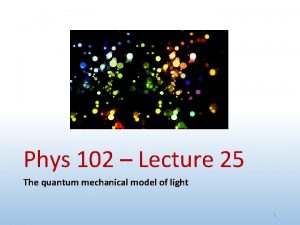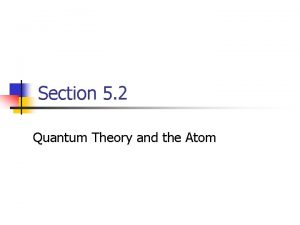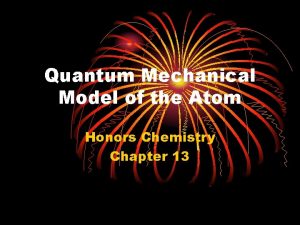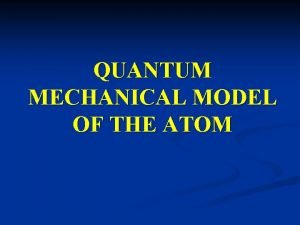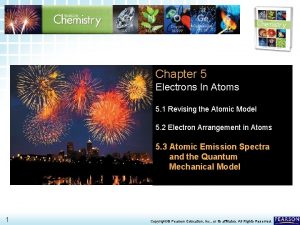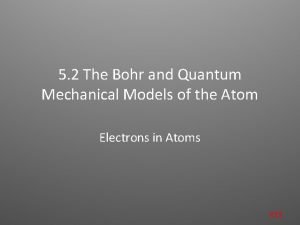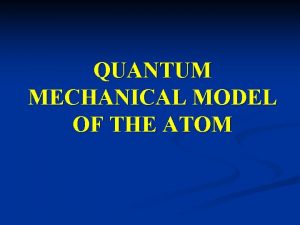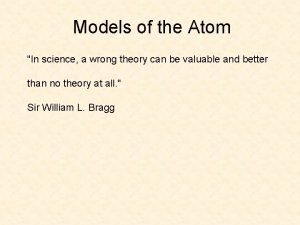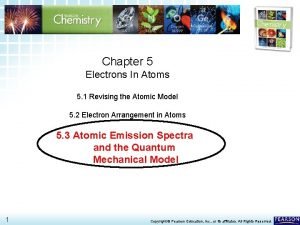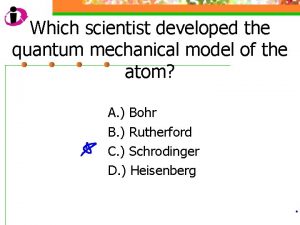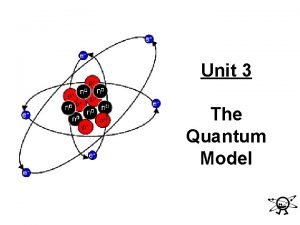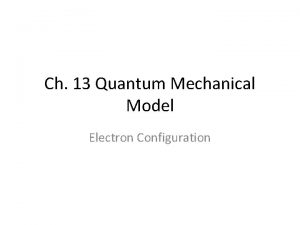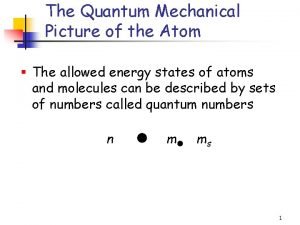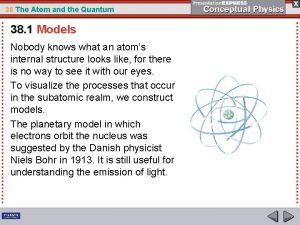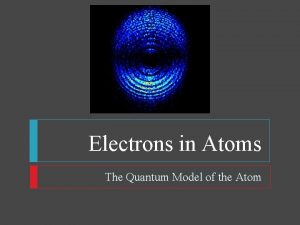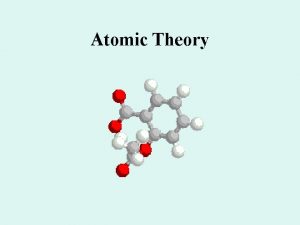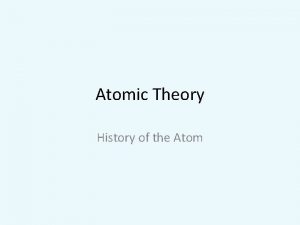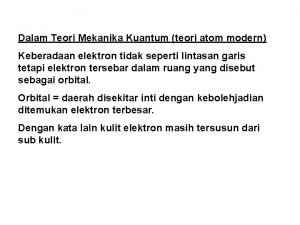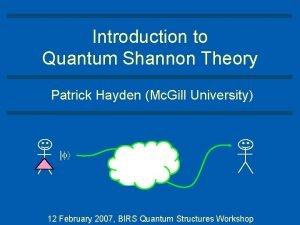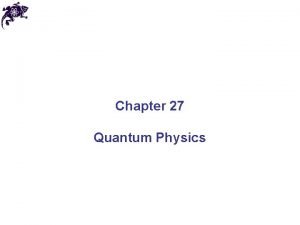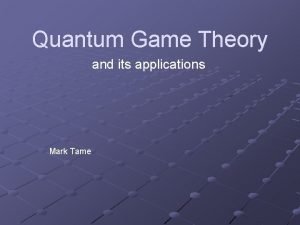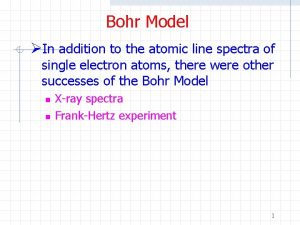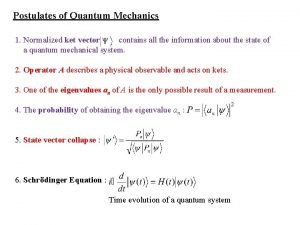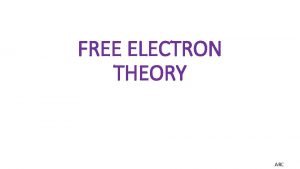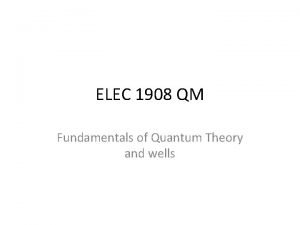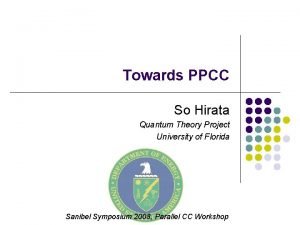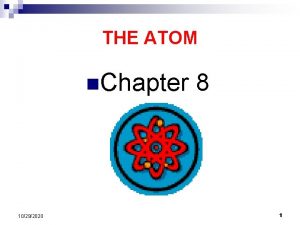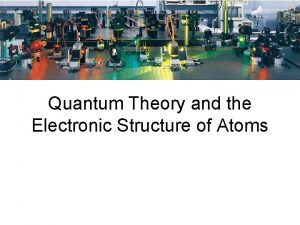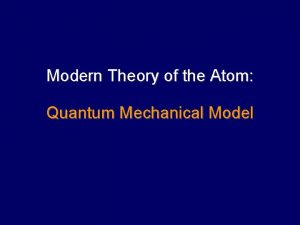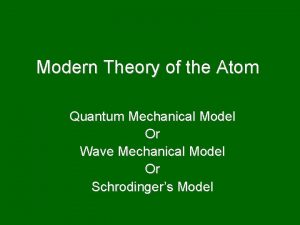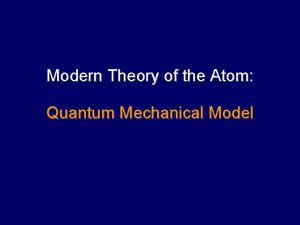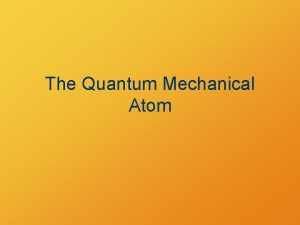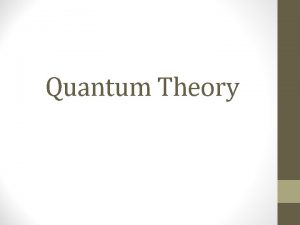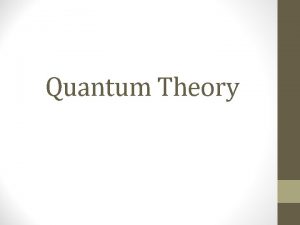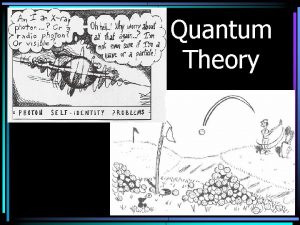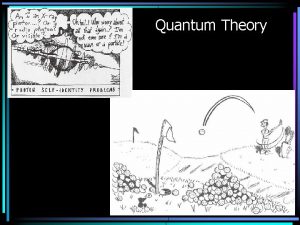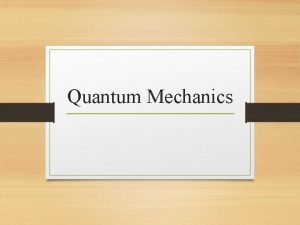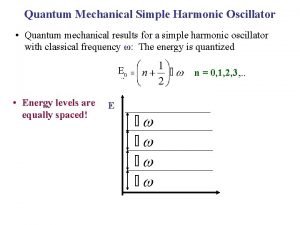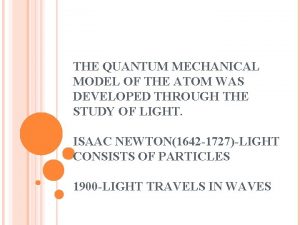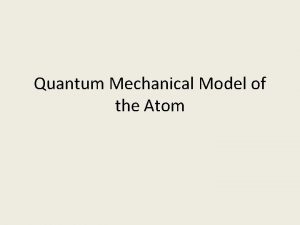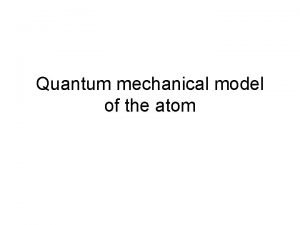Modern Theory of the Atom Quantum Mechanical Model

















































- Slides: 49

Modern Theory of the Atom Quantum Mechanical Model Or Wave Mechanical Model Or Schrodinger’s Model

source

Recap of Bohr Model • Electrons treated as particles moving in circular orbits. Specify speed, position, energy. • Quantization of energy levels is imposed. • Ground state: electrons close to nucleus • Electron transitions between energy levels can occur. Higher energy levels are farther from nucleus. – Moving up, electron absorbs energy – Moving down, electron emits light energy • Wavelengths of light in H spectrum can be predicted. Depend on energy difference of 2 levels involved in transition.

source

Problems with Bohr Model • Only worked for 1 -electron systems. • Quantization of energy levels had to be “imposed. ”

By the end of the 1800’s … • Physicists thought they were done! • Light or energy was waves. Could come in any frequency or wavelength. No mass. Delocalized. • Matter was particles. Have mass. Specify position. • Nice packages, everything done. Matter & Energy were DIFFERENT! • But there was trouble ahead!

Two problems • Black body radiation • Photoelectric effect

Energy of a photon • Einstein proposed that light comes in discrete packages called photons. • Einstein: Ephoton = h • All radiation is quantized! • Each energy of radiation will have its own frequency.

Photoelectric Effect

Photons • One photon can give all its energy to one electron. One electron can only accept one photon. • So if the photon is energetic enough, the electron will escape from the metal. If the photon is low energy, the electron can’t escape. (Threshold) • Brighter light means more photons so more electrons can escape. (Number)

Wave-particle Duality • Light can’t be forced into categories like everyday objects. • In some situations, light exhibits interference phenomena, like water waves. • In some situations, light shows energy transfers like particles in a collision.

E = mc 2 • Ephoton = hc/ = mc 2 • So m = hc/ c 2 • m = h/ c for a photon.

Electrons as Waves • 1924: Louis de Broglie: Dual nature of MATTER • Suggested that since light can act like a particle, maybe a particle, the electron, can act like a wave. • m = h/ c for a photon. • Electrons are not electromagnetic waves. They are “matter waves. ” • m = h/ v where v = velocity of the particle.

2 kinds of waves Traveling wave • Wave is not confined to a given space • Travels from one location to another • Interrupted by a boundary or another wave Standing wave • Confined to a given space. (Ends pinned. ) • Interference between incident & reflected waves. • At certain frequencies, certain points seem to be standing still. • Other points, displacement changes in a regular way.

Standing waves in music Applet with violin string So boundary conditions result in only some wavelengths that will fit on the string: “quantization” Wave: reflection of a pulse at a fixed end Interference of two waves traveling through a medium

De. Broglie Electron-Wave The wavelength describing an electron depends on the energy of the electron. At certain energies, electron waves make standing waves in the atom. The wave does not represent electron path. Only certain wavelengths will “fit. ”

De. Broglie Electron Waves These wavelengths will “work. ” This wavelength will not “work. ”

Bright spots result from constructive interference of waves. The waves are in phase (peaks match). Dark areas result from destructive interference of waves. Waves are out of phase. Only waves make diffraction patterns.

Modern Theory • Electron is treated as a standing wave. • Cannot specify both position & velocity of electron. • Can determine probability of locating the electron in a given region of space. • Quantized energy levels arise naturally out of wave treatment. • Also called Quantum Mechanics or Wave mechanics. Scientist = Schrodinger.

Bohr Model vs. Modern Theory • Electron = particle • Orbit • Holds 2 n 2 electrons • Spherical • Each orbit has a specific energy • Can find position, speed • Electron = Wave • Orbital • Holds 2 electrons • Not necessarily spherical • Each orbital has a specific energy • Probable location

Schrödinger’s Equation Ĥ = E • Solve for , the wave functions. • 2 gives the probability of finding an electron near a particular point in space. – Represented as probability distribution or electron density map.

Heisenberg uncertainty principle • Fundamentally impossible to know the velocity and position of a particle at the same time. • Impossible to make an observation without influencing the system. – A photon colliding with an electron will knock it off its path.

Orbital – Modern Theory • Orbital = term used to describe region where an electron might be. • Each orbital has a specific energy and a specific shape. Each holds 2 electrons. • Described by 4 parameters in the wave function – quantum numbers = n, l, m, s – like an address

s orbitals ( 2)

p orbitals

d orbitals

What can orbitals do for us? • Physical structure of orbitals explains – Bonding – Magnetism – Size of atoms – Structure of crystals

Quantum Numbers • Each electron in an atom has a set of 4 quantum numbers – like an address. – 3 quantum numbers describe the orbital – 1 quantum number gives the electron spin • No two electrons can have all 4 quantum numbers the same. (Pauli exclusion principle)

Energy level diagram for orbitals of Hydrogen atom. ĤΨ = EΨ can be solved exactly Only 1 electron.

Energy Level Diagram Energy levels for Polyelectronic atom

n: principal quantum number • Related to size and energy of orbital • n has integral values: 1, 2, 3, 4, … • As n increases, the orbital becomes larger & the electron spends more time farther from the nucleus, which also means higher energy.

l = angular momentum quantum number • Related to shape of orbital. • l has integral values from 0 to n -1 for each value of n. • Orbitals with different shapes have slightly different energies. Each type of orbital resides on a different sublevel of the principle energy level.

l = angular momentum quantum number • Principal energy levels are made up of sublevels. • The number of sublevels depends on the principal energy level. – – 1 st principal energy level has 1 sublevel 2 nd “ “ 2“ 3 rd “ “ 3“ 4 th “ “ 4 “, etc.

Naming sublevels • Sublevels are usually labeled s, p, d, or f instead of using more numbers. • • If l = 0, call it an s orbital. If l = 1, call it a p orbital. If l = 2, call it a d orbital. If l = 3, call it an f orbital.

ml = magnetic quantum number • ml related to orientation of orbital in space relative to other orbitals in the atom. • ml has integral values between l and -l, including 0. – For n = 1, l = 0 and ml = 0. – For n = 2, l = 0 or 1. • If l = 0 then ml = 0 • If l = 1, then ml = -1, 0, or +1.

orbitals • Sublevels are made up of orbitals • Each kind of sublevel has a specific # of orbitals Sublevel # of orbitals s 1 p 3 d 5 f 7

Spin quantum number, ms • ms describes the spin state of the electron in the orbital. • ms has two possible values: + ½ and – ½ • Pauli exclusion principle: No two electrons in the same atom can have all 4 quantum numbers the same. So each orbital can hold only two electrons.

Orbitals • Each orbital can hold two electrons with opposite spins. – s sublevels, 1 orbital: 2 e- max capacity – p sublevels, 3 orbitals: 6 e– d sublevels, 5 orbitals: 10 e– f sublevels, 7 orbitals: 14 e-

Prin. En. Lev Sublevels 1 s 2 s p 3 s p d 4 s p d f # orbitals/sl Total # elec 1 2 3 6 5 10 7 14

3 rd principal energy level, 3 sublevels 2 nd principal energy level, 2 sublevels – s & p 1 st principal energy level, 1 sublevel – s Each box represents an orbital and holds 2 electrons.

Order of fill: Aufbau principle • Each electron occupies the lowest orbital available • Learn sequence of orbitals from lowest to highest energy • Is some overlap between sublevels of different principal energy levels

Diagonal Rule 1 s 2 s 3 s 4 s 5 s 6 s 7 s 2 p 3 p 4 p 5 p 6 p 7 p 3 d 4 d 5 d 6 d 4 f 5 f 6 f Sequence of orbitals: 1 s, 2 p, 3 s, 3 p, 4 s, 3 d, 4 p, 5 s, 4 d, … Follow the arrows Exceptions do occur: half-filled orbitals have extra stability.

Hund’s Rule • Distribution of electrons in equal energy orbitals: Spread them out as much as possible! • Also, all electrons in singly occupied orbitals must have the same spin state.

Electron Configurations

Compare Bohr & Schrodinger

Frequencies in Chemistry

Electron Configuration & P. T.


Principle Energy Levels n = 1, 2, 3, 4 Holds 2 n 2 Electrons max Hold 2 Sublevels Orbitals Electrons Max 1 st energy level has 1 sublevel : s 2 nd “ “ “ 2 sublevels : s and p 3 rd “ “ “ 3 “ : s, p, and d 4 th “ “ “ 4 “ : s, p, d, and f s sublevel holds 1 orbital p sublevel holds 3 orbitals d sublevel holds 5 orbital f sublevel holds 7 orbitals
 Quantum mechanic model
Quantum mechanic model Schrodinger wave mechanical model
Schrodinger wave mechanical model The quantum mechanical model of the atom ____.
The quantum mechanical model of the atom ____. Modern quantum mechanical model
Modern quantum mechanical model Quantum mechanical model vs bohr model
Quantum mechanical model vs bohr model Kelemahan teori atom bohr adalah
Kelemahan teori atom bohr adalah Quantum mechanical model
Quantum mechanical model Electrons in atoms section 2 quantum theory and the atom
Electrons in atoms section 2 quantum theory and the atom Quantum atom model
Quantum atom model Quantum mechanical orbital
Quantum mechanical orbital Sublevel d
Sublevel d What is the electron configuration of 24cr4+?
What is the electron configuration of 24cr4+? Atomic emission spectra and the quantum mechanical model
Atomic emission spectra and the quantum mechanical model Quantum mechanical model
Quantum mechanical model Quantum number of oxygen
Quantum number of oxygen Erwin schrödinger atomic theory
Erwin schrödinger atomic theory Atomic emission spectra and the quantum mechanical model
Atomic emission spectra and the quantum mechanical model Which scientist developed the quantum mechanical
Which scientist developed the quantum mechanical Schrodenger
Schrodenger E=h x v
E=h x v Quantum mechanical model picture
Quantum mechanical model picture Classical physics
Classical physics Quantum physics vs quantum mechanics
Quantum physics vs quantum mechanics Chapter 38 the atom and the quantum
Chapter 38 the atom and the quantum Compare and contrast bohr model to quantum model
Compare and contrast bohr model to quantum model Atoms graphic organizer
Atoms graphic organizer The structure of the atom section 2 defining the atom
The structure of the atom section 2 defining the atom Actual mechanical advantage vs ideal mechanical advantage
Actual mechanical advantage vs ideal mechanical advantage Atomic model history
Atomic model history Bilangan kuantum 20ca
Bilangan kuantum 20ca Modern atom teorisi alt başlıkları
Modern atom teorisi alt başlıkları Quantum shannon theory
Quantum shannon theory Dual nature of light
Dual nature of light Quantum game theory
Quantum game theory Moseley law formula
Moseley law formula Postulates of quantum mechanics
Postulates of quantum mechanics Merits of classical free electron theory
Merits of classical free electron theory Hydrogen wave function
Hydrogen wave function Quantum theory project
Quantum theory project Quantum theory of light
Quantum theory of light Quantum theory and the electronic structure of atoms
Quantum theory and the electronic structure of atoms Hình ảnh bộ gõ cơ thể búng tay
Hình ảnh bộ gõ cơ thể búng tay Ng-html
Ng-html Bổ thể
Bổ thể Tỉ lệ cơ thể trẻ em
Tỉ lệ cơ thể trẻ em Voi kéo gỗ như thế nào
Voi kéo gỗ như thế nào Chụp tư thế worms-breton
Chụp tư thế worms-breton Bài hát chúa yêu trần thế alleluia
Bài hát chúa yêu trần thế alleluia Kể tên các môn thể thao
Kể tên các môn thể thao Thế nào là hệ số cao nhất
Thế nào là hệ số cao nhất
